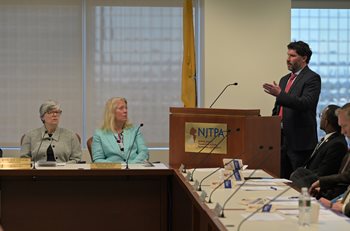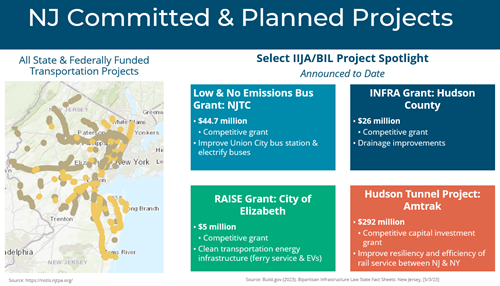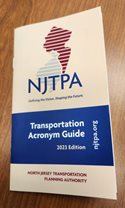May 2023
Posted: 5/25/2023 4:38:34 PM
Thirty-two municipalities in the NJTPA region will share almost $36 million for community based “non-traditional” transportation related projects designed to strengthen the cultural, aesthetic, and environmental aspects of the transportation system..
The grants come from the Transportation Alternatives Set-Aside (TA Set-Aside) program, administered by the New Jersey Department of Transportation (NJDOT) in partnership with the NJTPA, the Delaware Valley Regional Planning Commission (DVRPC), and the South Jersey Transportation Planning Organization (SJTPO). Grants are awarded every two years.
The competitive TA Set-Aside program provides funds to build pedestrian and bicycle facilities, create safe routes to school, preserve historic transportation structures, provide environmental mitigation, and create trail projects that serve a transportation purpose while promoting safety and mobility.
The 32 grants totaling $35.8 million were selected out of 68 applications that requested approximately $82 million in the NJTPA region during the solicitation round from May to November.
The grant awards in the NJTPA region are:
Bergen County
- Hackensack, $1,305,000 - Anderson Street City Streetscape Improvements Project (from Union Street to Linden Street)
- Edgewater, $763,000 - Grand Cove Drainage Improvement Project
- Fairview, $1,264,000 – Anderson and Fairview Avenue Restoration Project Phase IV
- Palisades Park, $1,407,000 – Broad Avenue Improvements Project
- North Arlington, $949,000 - Ridge Road Streetscape Phase III
- Bergenfield, $724,000 – Twin Boro Park Improvements Phase II
Essex County
- East Orange, $1,322,000 – East Orange Trail Project
- Orange, West Orange, $1,472,000 – Main Street Corridor Streetscape Project
- Montclair, $997,000 – Glenridge Avenue Cycle Track Phase II
- Orange, $1,488,000 – Scotland Road Gateway Beautification Project
- West Orange, $707,000 – Washington Street Corridor Improvement Project Phase II
Hudson County
- Jersey City, $760,000 – Hackensack Riverwalk
- Hoboken, $1,389,000 – Willow Avenue Vision Zero Improvements
- Bayonne, $1,500,000 – South Cove Pedestrian Bridge Project
Hunterdon County
- High Bridge, $520,000 – Streetscaping and Sidewalk Replacement
Middlesex County
- Carteret, $1,500,000 – Carteret Waterfront Multi-Use Pathway Project
- Plainsboro, $1,272,000 – Schalks Crossing Road Multi-Use Pathway
- Old Bridge, $1,399,000 – Cottrell Farm Park Pedestrian Safety Improvements Project
Monmouth County
- Long Branch, $1,480,000 – Ocean Boulevard (CR 57) between Passey Gardens and Joline Avenue (SR 36)
- Middletown, $1,500,000 – Campbell’s Junction Improvements Project
Morris County
- Chatham Township, $1,246,000 – Southern Boulevard to Green Village Connector Trail
- Washington Township, $808,000 – Non-Motorized Connectivity Improvements
Ocean County
- Seaside Heights, $824,000 – Central Avenue Safety Improvements
Passaic County
- Passaic, $454,000 – Hamilton Avenue and State Street Improvements Project
- Paterson, $1,327,000 – Spruce Street Phase II
Sussex County
- Newton, $749,000 – Memory Park Connector Boardwalk
- Sussex, $644,000 – Route 23 South Streetscape
Union County
- Kenilworth, Roselle Park, $1,500,000 – Rahway Valley Rails-to-Trails Project
- Summit, $1,110,000 – Summit Park Line Project Phase II
- Berkeley Heights, $1,275,000 – Sherman Avenue Transit Access Project
- Elizabeth, $780,000 – Elizabeth Avenue Streetscape Phase IV
Warren County
- Phillipsburg, $1,368,000 – Riverfront Heritage Trail Phase I
Posted: 5/12/2023 8:28:26 AM
Metropolitan Planning Organizations (MPOs) like the NJTPA across the U.S. are striving to help local governments take advantage of historic funding available for infrastructure and transportation, which is bringing once-in-a-generation opportunities in the coming years.
 Bill Keyrouze, executive director of the Association of Metropolitan Planning Organizations (AMPO), provided an overview of these increased resources available through the Infrastructure Investment and Jobs Act (IIJA) as well as the challenges associated with them, in a presentation at the May 8 meeting of the NJTPA Board. A video of the presentation is here.
Bill Keyrouze, executive director of the Association of Metropolitan Planning Organizations (AMPO), provided an overview of these increased resources available through the Infrastructure Investment and Jobs Act (IIJA) as well as the challenges associated with them, in a presentation at the May 8 meeting of the NJTPA Board. A video of the presentation is here.
Despite significant funding available through IIJA, many local governments face challenges in developing applications due to staffing shortages and lack of matching funding, according to Keyrouze.
“We know that’s a struggle across the country. It’s a lot to navigate and understand if you have a project,” Keyrouze said. Moreover, preparing an application has no guaranteed return on investment since most grant programs are competitive. AMPO, he said, is “constantly working with the U.S. Department of Transportation (USDOT) on guidance and trying to understand how to better implement all this.”
He said that new federal technical assistance programs, such as the Thriving Communities program, are available to assist with application development. In addition, new federal tools, such as the Discretionary Grants Dashboard, help identify appropriate grant opportunities. The NJTPA, for its part, has been providing consultation, technical assistance and letters of support for applications.
“Our message is that a rising tide raises all ships,” Keyrouze said. “If we collectively -- at the local, regional or state level -- can all work better together, then we all win at the end of the day. It’s about the services that we’re providing and delivering.”
 Keyrouze said New Jersey is doing “very well” compared to other states in receiving IIJA funding. Thus far, he said the state has received $5.5 billion in both discretionary and formula funding, underwriting 92 projects. Over the five-year life of IIJA, discretionary funding totals $28 billion of the $100-billion provided by the law – up from $5.5 billion in the previous federal transportation funding law.
Keyrouze said New Jersey is doing “very well” compared to other states in receiving IIJA funding. Thus far, he said the state has received $5.5 billion in both discretionary and formula funding, underwriting 92 projects. Over the five-year life of IIJA, discretionary funding totals $28 billion of the $100-billion provided by the law – up from $5.5 billion in the previous federal transportation funding law.
New guidelines written into the bill also encourage MPOs to work more closely with housing agencies. The Arlington, Va.-based AMPO has been coordinating with USDOT and Department of Housing and Urban Development (HUD) to identify best practices to better coordinate transportation, land use and housing policies.
Keyrouze shared a recent example of the often unappreciated impacts of transportation grants. School buses in a suburban Atlanta school district were outfitted with sensors to pre-empt red traffic lights along their route, speeding their trips. An unexpected benefit was that drivers saw fewer student disruptions, which often occurred when stopped at red lights. In addition, all students arrived in time to take advantage of free breakfast provided at school, which some previously missed due to delays.
“Sometimes it’s nice to step back and think about the impact that we can have as transportation planners and local elected officials. We often get caught up in the day to day and lose sight of the bigger picture,” Keyrouze said.
“Our work doesn’t have to be complicated to be consequential,” NJTPA Chair John Bartlett agreed.
Posted: 5/8/2023 2:38:39 PM
 Quick—what do IIJA, NOFO, RSA, SS4A, TNC stand for? They are among the new entries in the 2023 edition of the NJTPA Acronym guide, available here. The guide lists 180 acronyms commonly used in the transportation planning process overseen by NJTPA. (Answer: Infrastructure Investment and Jobs Act, Notice of Funding Opportunity, Road Safety Audit, Safe Streets and Roads for All, Transportation Network Company.)
Quick—what do IIJA, NOFO, RSA, SS4A, TNC stand for? They are among the new entries in the 2023 edition of the NJTPA Acronym guide, available here. The guide lists 180 acronyms commonly used in the transportation planning process overseen by NJTPA. (Answer: Infrastructure Investment and Jobs Act, Notice of Funding Opportunity, Road Safety Audit, Safe Streets and Roads for All, Transportation Network Company.)